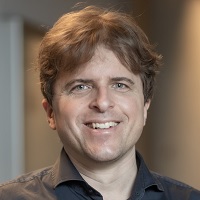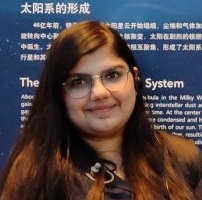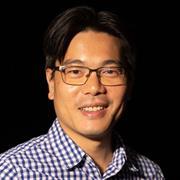Keynote Speakers and Tutorials
| |
Keynote Speakers
|
|

|
Monday 11th March 09:30-10:30
Title: From green networking to network virtualization: some interesting problems arising from telecommunication applications.
Bernardetta Addis has been a Full Professor in Computer Science at Polytech Nancy - Université de Lorraine and responsible for the “Networks, Systems and Services” department at LORIA (Computer Science laboratory of Lorraine) since September 2023. Before, she was an Assistant Professor at Ecole de Mines de Nancy - Université de Lorraine for 10 years.
Her research interests are Network Optimization, Discrete and Global Optimization, and Mathematical Programming Modelling and Metaheuristics to solve real-life applications (telecommunications, healthcare management, and process synthesis).
Abstract: Telecommunication networks and, more broadly, information and communication technology (ICT), are integral components of modern society. Their rapid evolution and growing sophistication present significant challenges to the optimization community.
In this talk, we introduce optimization problems we have tackled in collaboration with telecommunication experts over the past decade. The first half focuses on energy-aware network management, highlighting the importance of efficient routing and dynamic device switching. This approach is crucial for reducing energy consumption without compromising quality of service (QoS).
The second part of the presentation explores a problem arising from the convergence of network and computing systems: the placement and routing of Virtual Network Functions (VNFs). This second application involves a novel combination of network design and facility location optimization. Our contributions include mathematical programming models, a comprehensive analysis of their performance in a realistic setting, and a comparative analysis of its computational complexity compared to current state-of-the-art formulations.
|
|

|
Tuesday 12th March 09:30-10:30
Title: Self-adjusting networks
Stefan Schmid is a Professor at the Technical University of Berlin, Germany. MSc and PhD at ETH Zurich, Postdoc at TU Munich and University of Paderborn, Senior Research Scientist at T-Labs in Berlin, Associate Professor at Aalborg University, Denmark, Full Professor at the University of Vienna, Austria, and Sabbatical as a Fellow at the Israel Institute for Advanced Studies (IIAS), Israel. Stefan Schmid received the IEEE Communications Society ITC Early Career Award 2016 and an ERC Consolidator Grant 2019.
Abstract: In this talk, I will present the vision of self-adjusting networks: networks ("graphs") which are optimized towards, and “match”, the traffic workload they serve. These networks find applications for example in datacenters: Over the last years, the bandwidth and latency requirements of modern datacenter applications have led researchers to propose various datacenter topology designs using static, dynamic demand-oblivious (rotor), and/or dynamic demand-aware switches. However, given the diverse nature of datacenter traffic, there is little consensus about how these designs would fare against each other. We will discuss information-theoretic metrics to quantify the structure in communication traffic as well as the achievable performance in datacenter networks matching their demands, present network optimization principles accordingly, and identify open research challenges. I will also show how the notions of self-adjusting networks and demand-aware graphs relate to classic optimization problems in theoretical computer science.
|
|

|
Wednesday 13th March 09:30-10:30
Title: Benders Adaptive-Cuts Method Applied to Network Design and Facility Location Problems Under Uncertainty
Ivana Ljubić is Professor of Operations Research at the ESSEC Business School of Paris. She holds a PhD degree in computer science from the Vienna University of Technology (2004). Prior to joining ESSEC in 2015, she was appointed at the University of Vienna, where she also received her habilitation in Operations Research in 2013. Research interests of Ivana Ljubic include combinatorial optimization, optimization under uncertainty and bilevel optimization, with applications in network design, telecommunications, and logistics. She is member of the Editorial Board of the European Journal of Operational Research, Computers & Operations Research and she is currently an Associate Editor for Operations Research, Transportation Science and Networks.
Abstract: Benders decomposition is one of the most applied methods to solve two-stage stochastic problems (TSSP) with a large number of scenarios. The main idea behind the Benders decomposition is to solve a large problem by replacing the values of the second-stage subproblems with individual variables and progressively forcing those variables to reach the optimal value of the subproblems, dynamically inserting additional valid constraints, known as Benders cuts. Most traditional implementations add a cut for each scenario (multicut) or a single cut that includes all scenarios. In this talk, we present a novel Benders adaptive-cuts method, where the Benders cuts are aggregated according to a partition of the scenarios, which is dynamically refined using the LP-dual information of the subproblems. This scenario aggregation/disaggregation is based on the Generalized Adaptive Partitioning Method, which has been successfully applied to TSSPs. Our new method can be interpreted as a compromise between the Benders single-cuts and multicuts methods, drawing on the advantages of both sides, by rendering the initial iterations faster (as for the single-cuts Benders) and ensuring the overall faster convergence (as for the multicuts Benders). We will demonstrate how Benders adaptive-cuts can be applied to the Stochastic Multi-Commodity Network Design Problem and the conditional value-at-risk (CVaR) Facility Location Problem. The new method outperforms the other implementations of Benders methods, as well as other standard methods for solving TSSPs, in particular when the number of scenarios is very large. Moreover, our study demonstrates that the method is not only effective for the risk-neutral decision makers, but also that it can be used in combination with the risk-averse CVaR objective.
References: C. Ramirez-Pico, I. Ljubic, E. Moreno: Benders Adaptive-Cuts Method for Two-Stage Stochastic Programs, Transportation Science, online first, (2023), https://doi.org/10.1287/trsc.2022.0073
|
| |
Tutorials
|
|


|
Monday 11th March 14:00-15:30
Scott McDonald and Kanika Sharma Eaton
Tutorial 1 title: Buildings as Smart Grid Network Components
Scott McDonald is a Lead Data Scientist within Eaton’s Centre for Intelligent Power, based in Dublin. As part of the Buildings as a Grid team, he works on forecasting and optimisation problems related to commercial buildings and microgrids. He graduated from Ulster University in 2016 with a PhD in Machine Learning. His PhD work focused on applying computational intelligence approaches to financial time series problems. Prior to that, he graduated with an MSc in Financial and Industrial Maths and BSc in Quantitative Finance from Dublin City University. Before joining Eaton, Scott worked as a model developer in an Irish bank, working on stress testing and financial risk models.
Kanika Sharma is working as a Senior Data Scientist at the Centre of Intelligence Power (CIP) in Eaton, Ireland. She works on the ‘Building-as-a-grid project’ which focuses on optimization of energy usage in commercial buildings. Her work includes optimizing the scheduling of different assets in the building to reduce the energy bills in commercial buildings. She was awarded her PhD degree from the South East Technological University, Waterford, Ireland in Dec 2022. She works on theoretical computer science with a focus on building new computing paradigms like scaling and deploying distributed and flexible services on moving infrastructure. In her PhD, she worked on building predictive models to detect vehicular density and initiate vehicular clusters that can be used to deploy both distributed data collection and processing applications. She modelled the distributed service scaling and placement problem as a constrained optimization problem. She also secured funding from a European Commission Programme to visit universities in USA to extend her project on federated learning for pedestrian detection to reduce the risk of vulnerable road users. She also worked with Huawei Research Labs on SMT-based constrained optimisation for configuration synthesis in complex network.
Tutorial Abstract: Buildings are becoming energy hubs. Building owners and operators need to be prepared for the future and meet new regulations – design future buildings, integrate EV chargers or leverage renewable energy produced on site while managing the energy flows and planning power capacity. Reducing emissions to mitigate climate change is fast becoming law across Europe. The switch to electric vehicles and on-site energy generation are part of the response, and this means integrating assets such as EV chargers, solar PV, and energy storage systems into buildings.
As buildings become energy hubs, Building Energy Management Software is needed to help the building manager reduce energy costs and CO2 emissions by collecting and analyzing data, and predicting and managing energy flows. This talk will specifically focus on analyzing the available data from hardware assets and using an optimizer to solve for the best control strategy of the controllable assets including battery energy storage system and diesel generators. We will discuss the modeling process of forecasting building load, PV production and EV load along with the design of the optimizer. The optimizer produces an optimized schedule for a customised horizon (e.g., next 24 hours) by constructing and solving mathematical models while still meeting energy demands and the objectives. |
|

|
Tuesday 11th March 14:00-15:30
Nam Tran, University College Dublin
Tutorial 2 Title: Optimization Methods for Large-scale Cell-free Massive MIMO
Nam Tran is an associate professor in the School of Electrical and Electronic Engineering in University College Dublin, . His research interests are primarily on applications of optimization techniques in wireless communications design. Some recent topics include energy-efficient communications, physical layer security, cloud radio access networks, cell-free massive MIMO, and re configurable intelligent surfaces. Dr. Tran is an Associate Editor for EURASIP Journal on Wireless Communications and Networking and IEEE Communications Letters. He was the Symposium Co-Chair of Cognitive Computing and Networking Symposium of International Conference on Computing, Networking and Communication (ICNC 2016) and was the Co-Chair of the Workshop on Scalable Massive MIMO Technologies for Beyond 5G at IEEE ICC 2020. He has also served on the Technical Program Committees of several IEEE major conferences. Dr. Tran was a recipient of the Career Development Award from Science Foundation Ireland in 2018. He is a co-recipient of an IEEE GLOBECOM 2021 Best Paper Award and an IEEE PIMRC 2020 Best Student Experimental Paper Award.
Tutorial Abstract: The speedy rollout of 5G networks across the globe over the past two years simply means now is the right time to envision what 6G looks like. Although 5G networks can support high data rates, beyond-5G/6G networks will need a paradigm shift in wireless access technologies to keep pace with the anticipated traffic explosion. In this talk I will introduce some fundamentals of cell-free massive multiple-input multiple-output (CFmMIMO) technology, which has been proposed as a solution to the inherent limitations of cellular systems and is considered to be a disruptive technology for beyond-5G/6G wireless networks. Without cell boundaries, CFmMIMO can offer uniformly good service for all users across the network.
This presentation will specifically focus on the design of CFmMIMO system from an optimization perspective. Due to the relatively small number of antennas per access point (AP), CFmMIMO typically requires a substantially large number of APs. This leads to large-scale resource allocation problems, calling for novel scalable methods to make CFmMIMO more practically feasible. In this context, I will introduce specific power control problems arising from CFmMIMO, describe associated challenges, and then showcase some of the current methodologies developed to achieve high-performance solutions. |
|
 International Network Optimization Conference (INOC) 2024, University College Dublin
International Network Optimization Conference (INOC) 2024, University College Dublin International Network Optimization Conference (INOC) 2024, University College Dublin
International Network Optimization Conference (INOC) 2024, University College Dublin